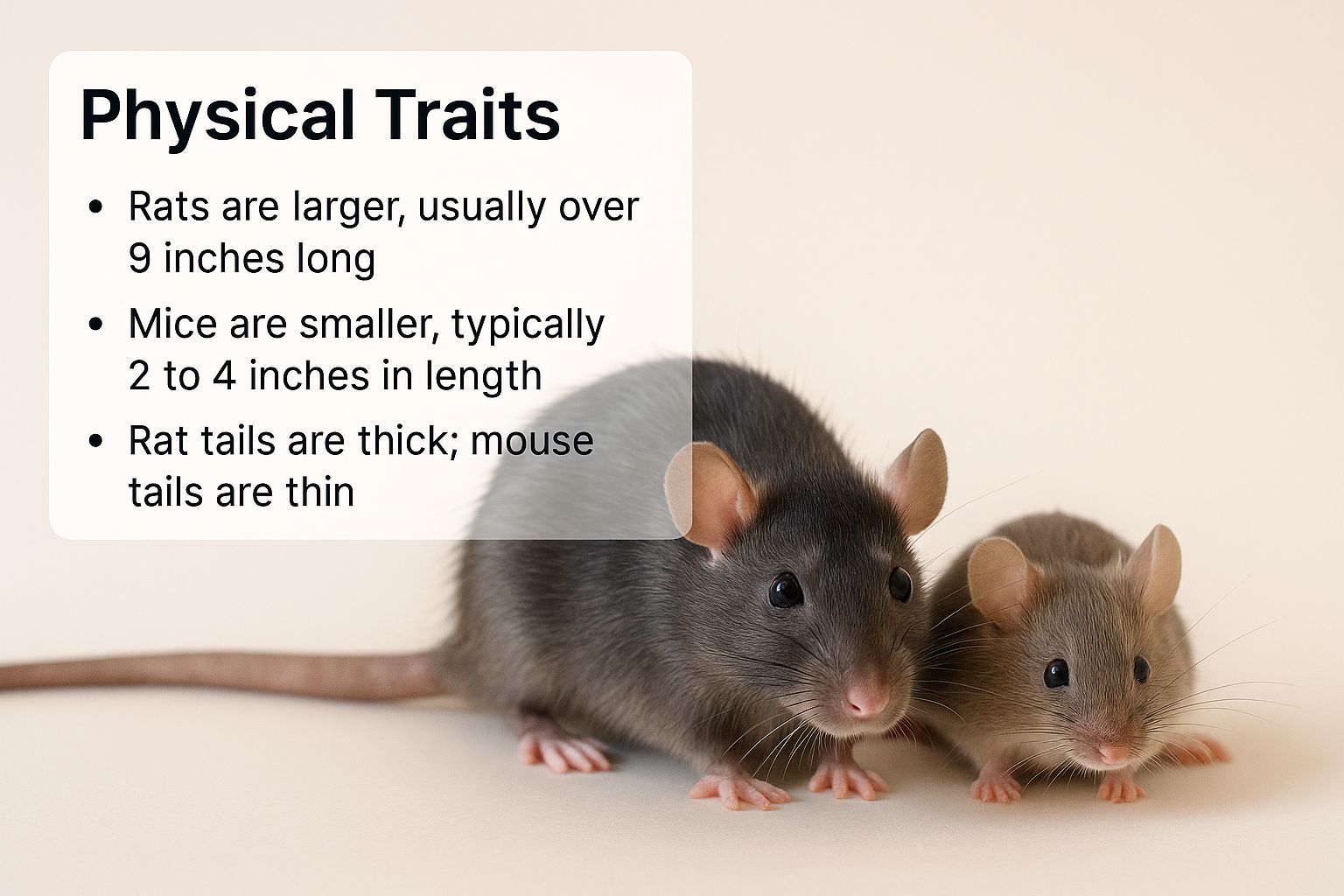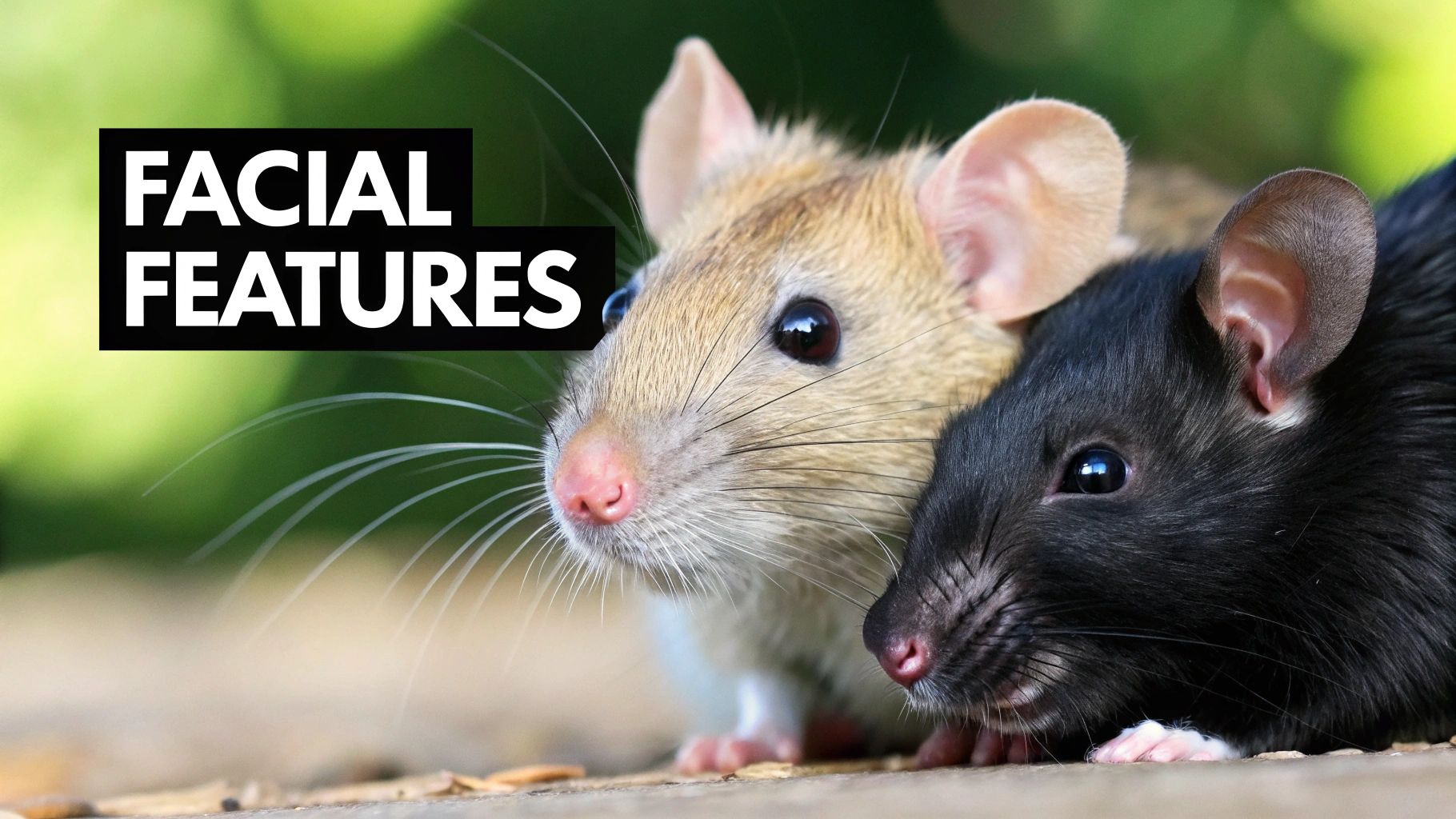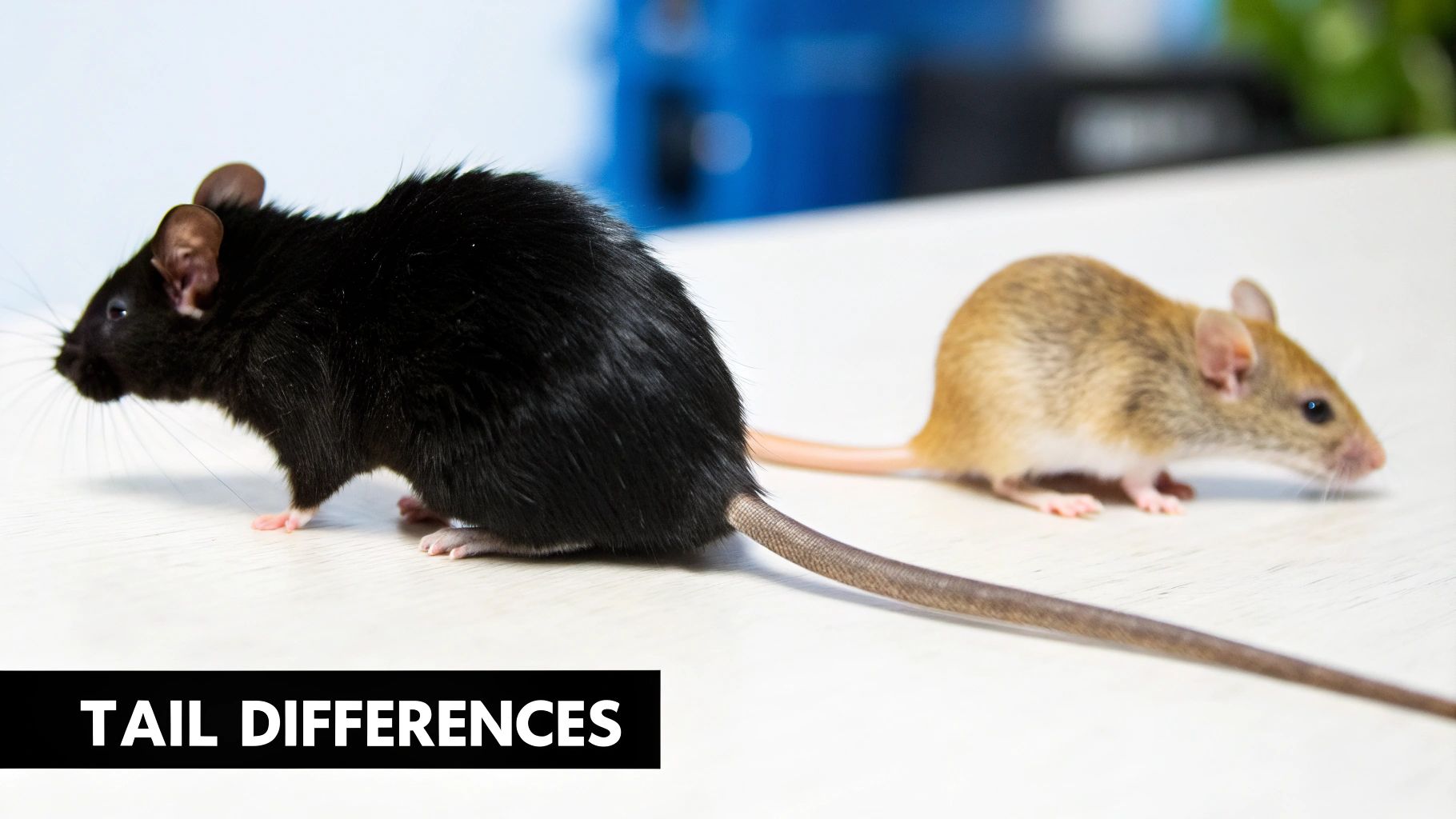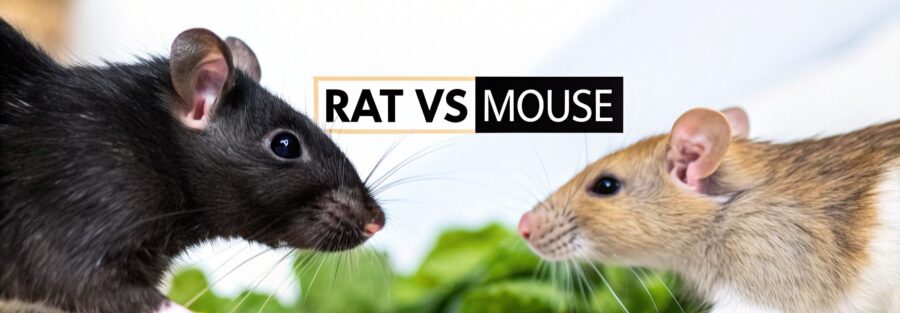Figuring out whether you have rats or mice is the first, and most important, step in dealing with a rodent problem. While it might seem obvious, the differences aren't always clear-cut, especially when you're dealing with a young rat that can look a lot like a fully grown mouse.
The truth is, these two pests are worlds apart in terms of their behaviour, the risks they pose, and how you need to tackle them. Getting it right from the start saves you time, money, and a lot of frustration.
Key Differences Between Rats and Mice at a Glance
So, what should you be looking for? It really boils down to a few distinct physical traits. If you get a good look at the intruder, or even just the evidence they leave behind, you can usually make a confident ID.
A quick glance at their core features makes telling them apart much easier.

The image above gives you a great side-by-side view, but let’s break down the most immediate identifiers you can use.
Quick Comparison Rat vs Mouse Identifiers
This table gives you a simple, at-a-glance guide to the most common signs you’ll encounter. Use it to quickly work out what you're up against.
| Feature | Brown Rat | House Mouse |
|---|---|---|
| Overall Size | Large & heavy; 20-30 cm body | Small & light; 6-10 cm body |
| Head & Snout | Blunt, broad nose | Small, pointed, triangular snout |
| Ears | Small relative to head | Large, floppy ears for its size |
| Tail | Thick, shorter than body, scaly | Thin, as long as or longer than body |
| Droppings | Large (1-2 cm), spindle-shaped | Small (4-7 mm), rice-grain shaped |
| Behaviour | Cautious of new objects (neophobic) | Curious and will investigate new items |
This quick rundown should help you pinpoint your pest. Remember, rats are cautious creatures, whereas mice are much more inquisitive, which is a key difference when it comes to trapping and baiting.
Key Takeaway: If the rodent has a blunt nose, a thick tail shorter than its body, and its droppings are large, you are almost certainly dealing with a rat. A small body with large ears and a long, thin tail points directly to a mouse. This initial identification shapes every subsequent step of your pest control plan.
A Detailed Physical Comparison of Rodents
While size is the most obvious starting point, a closer look at key physical traits reveals the undeniable differences between rats and mice. It’s a common mistake to misidentify a young rat for an adult mouse, but focusing on specific anatomical features provides the clarity you need for an accurate ID.
Getting these details right is the first step toward effective pest control.
The most substantial difference is sheer scale. Adult rats found in the UK, especially the brown rat (Rattus norvegicus), typically measure 20 to 30 cm in body length—and that’s not even including the tail. They can weigh up to a hefty 600 grams. You can find out more about the significant size of UK rats in this report from The Independent.
In stark contrast, the common house mouse (Mus musculus) is far smaller, measuring only 6 to 10 cm and weighing a tiny 12 to 30 grams. This massive size disparity influences every other physical feature, creating a distinct profile for each rodent.
Head Shape and Snout Features
A rodent’s head provides some of the most reliable clues for telling them apart. A rat has a heavy, almost brick-like head with a blunt, broad snout. This robust structure gives it a powerful bite, capable of gnawing through some surprisingly tough materials.
A mouse, on the other hand, has a small, triangular-shaped head that tapers down to a distinctly pointed snout. Its delicate, sharp features are perfectly suited for investigating tiny crevices and accessing small food sources like seeds and grains.
Visual Cue: If the rodent's face is blunt and broad, think rat. If it’s small and sharply pointed, you’re almost certainly looking at a mouse. This is one of the clearest differentiators, even from a distance.
Ears and Feet Proportions
The proportions of the ears and feet are a brilliant giveaway, especially when you’re trying to distinguish a young rat from an adult mouse. A young rat will have ears and feet that look clumsy and disproportionately large for its body—a classic trait in juvenile mammals.
An adult mouse, however, has features that are perfectly in proportion. Its ears are noticeably large and almost floppy relative to its small head, giving it an almost cartoonish look. Their feet are small and dainty, matching their slender frame perfectly.
- Young Rat: Large head and feet that look too big for its body.
- Adult Mouse: Small head and feet that are proportionate to its body.
A Tale of Two Tails
Finally, the tail is a definitive giveaway. A rat’s tail is a formidable feature—it’s thick, scaly, and often shorter than its body length. You'll also notice it’s typically pale on the underside and darker on top, adding to its distinct appearance.
A mouse’s tail is the complete opposite. It's thin and rope-like, usually covered in a very fine layer of hair. Critically, its tail is as long as, or even longer than, its entire body. By examining these detailed physical markers, you can confidently tell the difference between a rat and a mouse, ensuring you choose the right approach to get them out of your property.
Understanding Rodent Behaviour and Habits
Beyond their physical appearance, the way a rodent behaves is one of the most reliable clues to its identity. To really tell the difference between a rat and a mouse, you need to pay as much attention to their actions as you do to their size or tail. These distinct patterns are what ultimately guide a successful pest control strategy.
One of the biggest behavioural giveaways is how they react to new things in their environment. This psychological quirk is a genuine game-changer when it comes to trapping them.
Curiosity vs Caution
Rats are classic neophobes—a fancy way of saying they have an intense, instinctual fear of new objects. If you place a trap or bait station in a rat's territory, you can bet it will be ignored for days. The rat will cautiously watch from a distance, waiting to see if it’s a threat. This behaviour makes trapping them a slow, patient process.
Mice, on the other hand, are the complete opposite. They are incredibly inquisitive little explorers and will actively investigate anything new that appears in their path. Their natural curiosity means they are far more likely to check out a freshly placed trap almost immediately.
Expert Insight: A rat’s cautious nature versus a mouse’s curious mind is precisely why professional pest control strategies differ so much. What works for one will almost certainly fail for the other.
Nesting and Living Preferences
Where you find the nest is another huge giveaway. Rats are powerful burrowers and prefer to set up camp on the lower levels of a building or even outdoors under decking and sheds. Their nests tend to be more substantial, often dug into the ground or built into the fabric of a structure.
- Rats typically nest in: Basements, sewers, wall cavities near the ground, or in garden burrows.
- Mice prefer to nest in: Secluded, warmer spots like attics, behind kitchen appliances, inside old furniture, or within wall voids high off the ground.
This difference comes down to their size and what they’re built for. Rats are mainly nocturnal creatures that stick to a territory and need larger spaces to nest, which is why they thrive in sewers and basements. Mice are much smaller and can adapt to tiny indoor spaces like cupboards and wall cavities.
Their diets also differ. Rats are often drawn to high-protein waste from our bins, a common sight in UK cities. Mouse infestations, however, are usually entirely indoors and less tied to what’s happening with the bins outside. You can find more insights on this by looking into urban rodent habits on directlinegroup.co.uk.
Understanding these habits is crucial because it helps you predict where they’ll travel and hide. Mice, for example, can squeeze through shockingly small gaps to get to those hidden areas. If you suspect you have mice, knowing all the potential entry points is vital for proofing your home effectively. You can learn more about how mice get into your house in our detailed guide.
When you combine your knowledge of their physical traits with their behavioural patterns, you get a much clearer picture of the pest you’re dealing with. This allows for a targeted and, most importantly, successful control plan.
Analysing the Evidence Left Behind
More often than not, you'll see the signs of a rodent infestation long before you ever clap eyes on the culprit. Rodents are secretive, especially in the early days. Learning to read the clues they leave behind, however, turns you into a bit of a pest detective, allowing you to figure out exactly what you're up against.
These tell-tale signs are often tucked away where you least expect them—think along skirting boards, deep inside cupboards, or behind the fridge. Each piece of evidence tells a story. From the size and shape of their droppings to the damage they cause, these clues give a clear answer to the big question: rats or mice? Getting this right is the crucial first step.

Droppings: The Definitive Clue
Without a doubt, droppings are the most definitive piece of evidence you’ll find. Once you know what to look for, the difference between rat and mouse droppings is so stark there’s no room for confusion.
A single house mouse can leave behind between 40 and 100 droppings every single day. They’re tiny, dark, and shaped like little grains of rice, usually measuring about 4-7 mm. You’ll find them scattered around, especially in places mice frequent like kitchen worktops or inside pantries.
Rat droppings, on the other hand, are on another scale entirely. A brown rat produces about 40 droppings daily, but they are much bigger—up to 20 mm long. They look a bit like a large bean, often spindle-shaped with blunt ends. For a closer look, our guide on rat droppings size has more detailed visual comparisons.
Gnaw Marks and Structural Damage
Both rats and mice have teeth that never stop growing, which means they have to gnaw constantly to keep them in check. The damage they leave behind, though, looks very different and is a dead giveaway of their size and strength.
Mice tend to create small, neat holes, almost as if they've been tidily carved out. We're talking holes no bigger than a ten-pence coin. You'll also see them nibble on food packaging, leaving small, shredded openings.
Rats cause much rougher, more substantial damage. Their gnaw marks are large and coarse, and they can chew through some seriously tough materials—soft metals, cinder blocks, and even some types of concrete are no match for them. A hole from a rat will be large, with jagged, torn edges.
Real-World Example: Imagine you find a hole chewed through the bottom of a wooden shed door. If it's a small, clean-cut circle, it’s almost certainly a mouse. But if it’s a large, splintered opening a couple of inches wide, you’re looking at rat damage.
To make things clearer, here’s a quick breakdown of the physical evidence:
Evidence Breakdown Comparing Infestation Signs
This table helps you quickly compare the typical signs left by rats versus mice, from droppings to the damage they cause.
| Sign of Infestation | Rat Evidence | Mouse Evidence |
|---|---|---|
| Droppings | Large (up to 20 mm), blunt-ended, spindle-shaped. Found in concentrated areas. | Small (4-7 mm), pointed ends, like grains of rice. Scattered randomly. |
| Gnaw Marks | Large, rough, and coarse. Can chew through wood, plastic, and even soft metals. | Small, neat, and clean-cut. Typically found on food packaging, furniture, or wires. |
| Tracks & Smudges | Greasy, dark smudge marks along walls and skirting boards from oily fur. | Faint tracks may be visible in dusty areas, but smudges are rare. |
| Holes | Large, jagged entry holes, often 2+ inches wide with rough edges. | Small, clean-cut entry holes, about the size of a 10p coin. |
Paying attention to these details will tell you exactly which pest you're sharing your space with, which is essential for choosing the right treatment.
Nests and Runways
The final pieces of the puzzle are the nests and tracks that rodents create. These clues don't just confirm their identity; they also reveal their preferred hiding spots and travel routes through your property.
- Mouse Nests: Mice build small, cosy nests in well-hidden spots. They use soft, shredded materials like paper, fabric, cotton, and insulation. Look for them tucked away in wall voids, attics, or behind appliances.
- Rat Nests: Rats are more likely to burrow, creating nests underground in gardens, under decking, or in compost heaps. If they get inside, they’ll stick to the lower levels of a building—basements or crawlspaces—using rougher materials like insulation and wood chips.
Rats also leave behind a very specific sign: greasy, dark smudge marks along walls and skirting boards. These "runways" are created by the oil and dirt on their fur rubbing off as they use the same route repeatedly. It's a clear indicator of a well-established rat problem. Mice, being smaller and a bit cleaner, rarely leave such obvious marks.
Infestation Patterns in UK Homes and Cities

Sometimes, where you live gives you the biggest clue to your rodent mystery. To really tell the difference between a rat and a mouse problem, you have to look at the wider environment. Each pest thrives in its own kind of setting across the UK, and their patterns are often shaped by geography and opportunity.
As a rule of thumb, large-scale, widespread rodent problems are almost always a rat issue. Dense urban areas like London, Manchester, and Birmingham are perfect breeding grounds for the brown rat, with their ageing sewer systems and an endless supply of food waste. These environments offer everything a rat colony needs to explode in number.
Mouse infestations, on the other hand, tend to be more localised. While you’ll certainly find them in cities, a mouse problem is often contained to a single house, a block of flats, or a specific business. They’re less bothered about community-wide infrastructure and more focused on finding a small, secure spot to nest inside a building.
Urban vs Rural Rodent Dynamics
In big cities, rat populations are a systemic problem. The scale of the issue is staggering, with local authorities logging over 518,000 rat infestations between 2023 and mid-2025. London alone made up nearly 25% of these reports, which shows just how directly urban density fuels rat numbers.
This data really confirms it: if you’re in a city centre and suspect a widespread problem affecting your neighbours too, you're almost certainly dealing with rats. They are experts at using shared infrastructure like sewers and drains to move about unseen. Understanding what attracts rats to your house is the first step in protecting your property.
Mice, however, are the masters of the domestic space. A suburban home, a rural farmhouse, or even a small shop provides the perfect micro-habitat. Their infestations are often smaller in scale but can grow incredibly quickly if left to their own devices within the walls of a single property.
Situational Clue: If your neighbours are also complaining about rodents and you live near commercial bins or old drainage systems, the culprit is probably a rat. If the problem seems confined to just your property, especially in a quieter suburban or rural area, a mouse is the more likely intruder.
Assessing the Scale of Your Problem
Knowing these patterns helps put your own pest issue into context. It gives you a much clearer idea of whether you’re facing a contained problem or are just one part of a larger, community-wide challenge. This distinction is vital for planning how to tackle it effectively.
Of course, rats and mice aren't the only uninvited guests. It's always useful to be aware of other common household pests like bats, which can also find their way into lofts and voids.
Frequently Asked Questions About Rats and Mice
Even with all the evidence laid out, it’s completely normal to have a few lingering questions. When you're trying to figure out if you're dealing with a rat or a mouse, getting a clear answer is vital, as it directly impacts how you tackle the problem.
Here, we answer the most common queries we hear from homeowners and businesses across the UK. Think of this as practical, real-world advice to clear up any final confusion and help you move forward with confidence.
Can You Have Both Rats and Mice at the Same Time?
This is a common concern, but in reality, it's extremely rare to find active infestations of both rats and mice sharing the same space. Rats are simply bigger, more aggressive, and will actively hunt and kill mice to get rid of the competition. They're highly territorial and will dominate any area they move into.
If you’re seeing signs that seem to point to both, it’s far more likely that one species has recently forced the other one out. In almost every home we visit, it's one or the other—not a combined infestation.
Key Insight: Finding evidence of both rats and mice usually signals a takeover. A new rat population has likely driven out or even eliminated an existing mouse problem. In this scenario, rats are almost certainly your current threat.
Are Baby Rats the Same Size as Adult Mice?
This is probably the single biggest cause of misidentification we see. A young rat can be a similar length to a fully grown house mouse, but their body proportions are a dead giveaway once you know what to look for. The trick is to check the head and feet.
A baby rat will have a head and feet that look comically large and clumsy for its body. In contrast, an adult mouse’s head and feet are perfectly in proportion with its small, slender frame.
And don't forget the tail; it's another clear clue:
- Young Rat: Has a short, thick, almost stubby tail.
- Adult Mouse: Has a very long, thin, whip-like tail.
Why Is Identification So Important Before Pest Control?
Getting the identification right is absolutely critical because rats and mice need completely different control strategies. Their behaviours and instincts are fundamentally opposed, which means a technique that works for one will almost certainly fail for the other.
For example, rats have a natural fear of new things in their environment (neophobia). This means traps often need to be left unset for several days just so the rats can get used to them. On the other hand, mice are naturally curious and will investigate new traps almost immediately. Bait preferences, trap designs, and even how you seal entry points differ significantly between the two.
Giving your pest control professional the correct information from the start allows them to arrive with the right equipment and a ready-to-go strategy. This leads to a faster, safer, and much more effective solution, saving you time, money, and stress in the long run.
If you're still unsure or just want an expert opinion, don't hesitate. At Pest Predators Limited, we use our scientific expertise to accurately identify and effectively resolve any rodent problem. Contact us today for a professional consultation and a pest-free peace of mind.



